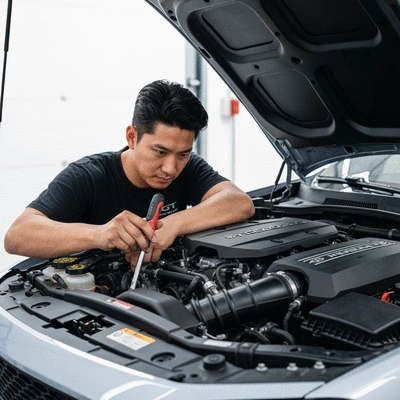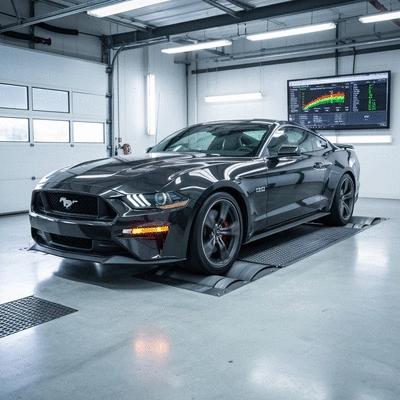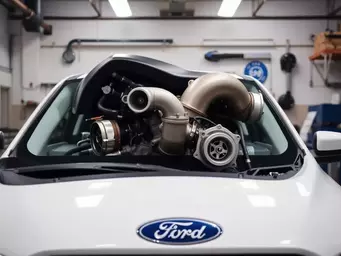Stage 1 Tuning
- HP Gain: 20-50 hp
- Torque Gain: 30-80 lb-ft
- Installation: 1-3 hours
- Reliability: High
- Cost: Lower

What if you could transform your Mustang GT into a high-performance machine with just a few key modifications? Understanding the differences between Stage 1 and Stage 2 tuning can help you navigate the exciting world of tuning and discover new levels of driving pleasure.
This visual compares the key differences between Stage 1 and Stage 2 tuning for the Mustang GT, highlighting performance gains, installation, reliability, and cost.
Tuning your Mustang GT is an exciting journey, one that can significantly enhance both performance and enjoyment behind the wheel. In the context of Mustang GT modifications, Stage 1 tuning typically entails basic enhancements such as reprogramming the engine's ECU and some light hardware upgrades. On the other hand, Stage 2 tuning pushes the envelope further, involving more extensive modifications like upgraded turbochargers or larger intercoolers. Understanding these stages helps you make informed decisions that align with your driving preferences and goals.

For many enthusiasts like myself, tuning isn't just about numbers; it's about the experience. Each stage reflects a different level of commitment to performance and can transform how your Mustang handles on the road. Let’s break down what these stages really mean for your car!
Stage 1 tuning is often considered the perfect entry point for those looking to get more from their Mustang without diving too deep into the modification world. It usually includes upgrades such as:
In contrast, Stage 2 tuning involves more aggressive modifications that require a deeper understanding of mechanics and driving dynamics. This stage may include:
As you can see, there’s a significant difference in the complexity and intensity of each tuning stage. When deciding, it's beneficial to consult resources like ASM Tuning's comparison of Stage 1 vs. Stage 2 tuning, which offers further insights into these differences. Choosing the right one can make a world of difference in your driving experience!
When it comes to performance gains, tuning your Mustang GT can yield impressive results! With Stage 1 tuning, you can typically expect an increase of about 20-50 horsepower and a torque boost of approximately 30-80 lb-ft. These enhancements can dramatically improve throttle response and overall drivability. For example, a COBB Tuning Stage 2 map for a Mustang EcoBoost can illustrate the kind of detailed calibration involved in achieving these gains.
On the other hand, Stage 2 tuning delivers more pronounced gains. Depending on the specific modifications made, you might see increases of 50-100 horsepower and an even more substantial torque increase, providing a thrilling driving experience. This stage is all about pushing your Mustang to its limits while ensuring that every drive is thrilling!
Now, let’s dive into some specific performance metrics that highlight the differences between Stage 1 and Stage 2 tuning. After tuning, you might find the following changes in your Mustang GT:
| Tuning Stage | Horsepower Gains | Torque Gains |
|---|---|---|
| Stage 1 | 20-50 hp | 30-80 lb-ft |
| Stage 2 | 50-100 hp | 80-150 lb-ft |
These benchmarks illustrate how each tuning stage can transform your driving experience. Stage 1 is perfect for everyday use with noticeable improvements, while Stage 2 offers a more dynamic and exhilarating ride. Understanding these differences can help you decide which stage aligns best with your performance goals!
As a Mustang enthusiast, how do you prioritize tuning your vehicle? Share your thoughts below:
When it comes to Stage 1 tuning, the benefits are quite clear. One of the top advantages is its ease of installation. This tuning stage typically requires minimal upgrades, allowing you to get back on the road quicker without extensive downtime. Additionally, Stage 1 is known for its reliability, making it a solid choice for those who use their Mustang GT as a daily driver.
However, it’s important to note the limitations as well. While the performance gains are noticeable, they may not satisfy those looking for extreme power boosts. If you’re aiming for high-performance racing or aggressive driving, you might find Stage 1 tuning lacking in overall horsepower and torque.

Now let’s shift gears and talk about Stage 2 tuning. This is where the fun really begins! The high-performance advantages are certainly appealing, offering significant horsepower and torque increases. With the right modifications, you can expect your Mustang GT to truly roar on the road!
That said, it’s essential to consider potential drawbacks, as Stage 2 tuning may compromise reliability and increase maintenance needs. This tuning stage often requires more expensive parts and labor, which means you should be prepared for a higher initial investment. Discussions on forums like Mustang6G threads comparing Stage 1 vs. Stage 2 can offer real-world perspectives on these considerations.
Let’s lay out a direct comparison between Stage 1 and Stage 2 tuning for clarity. Here’s a quick breakdown of performance outcomes, driveability, and maintenance requirements:
| Feature | Stage 1 Tuning | Stage 2 Tuning |
|---|---|---|
| Horsepower Gain | Up to 50 HP | Up to 100 HP |
| Torque Gain | Up to 40 lb-ft | Up to 80 lb-ft |
| Installation Time | 1-3 hours | 3-6 hours |
| Reliability | High | Moderate |
| Cost | Lower | Higher |
With these comparisons, it’s easier to see why many Mustang enthusiasts, including myself, often weigh the benefits of each stage carefully. It’s all about finding that sweet spot between performance and practicality!
Here is a quick recap of the important points discussed in the article:
Understanding Ford Suspension Upgrades

Ready to elevate your driving experience? Understanding Ford suspension upgrades is not just for the
Understanding Ford EcoBoost Upgrades

As we gear up for advancements in Ford's EcoBoost technology, understanding the potential of turbo u
Understanding Ford Suspension Upgrades
Ford Truck Tuning for Towing
Understanding Ford EcoBoost Upgrades
Classic Ford Inspection Checklist Guide
Ford Performance Chips: Real Results